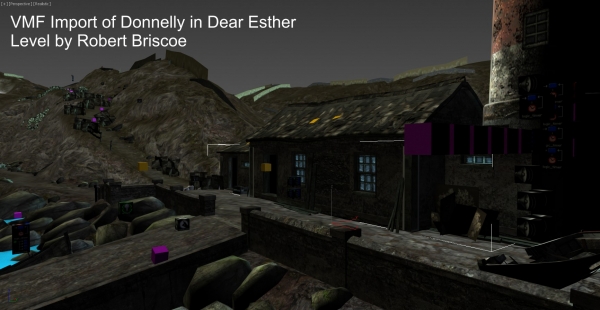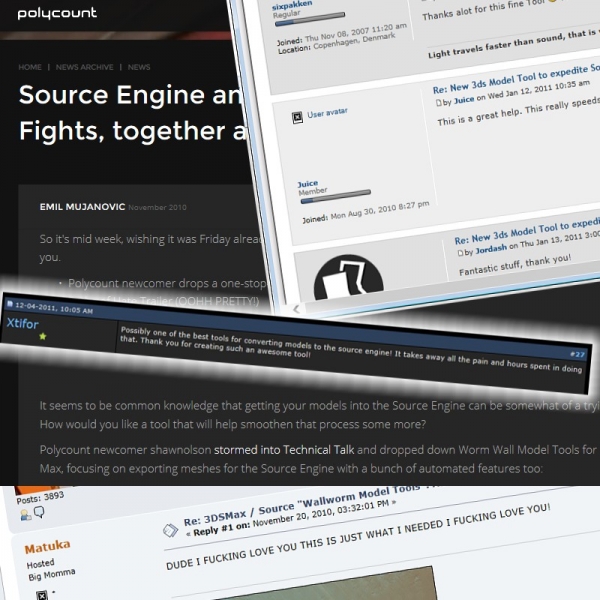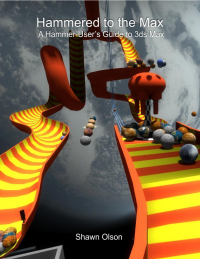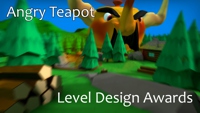Wall Worm Turns Five Years Old
Times fun when you're having flies, or so one of my favorite teachers used to say. It's hard to believe Wall Worm has now consumed half a decade of my life. The journey's been rewarding for me, both personally and professionally.
When I stepped onto the public stage with Wall Worm, I was an outsider. In fact, I still feel that way to a degree--not in a begrudging way, but just because I have never really fit into most of the design circles for Source. Mainly, I'm the crazy wizard living out in the desert people come visit to gain specific knowledge; but the visitors usually leave without really understanding the philosophy that drives my way of life.
Technically and explicitly this is about my own passion for using 3ds Max for Source Engine design even to the point of bypassing widely heralded tools like Hammer. But it's actually a little more than that. For me, game design is really only an expression of my overall love of creativity itself. Honestly, I don't get passionate about playing games. I enjoy games, but I'm not keen on keeping up with new hot titles or general trivia and news about them. If not for a chronic back injury, I'd play more basketball than video games any week.
In my view, a lot about games is just hype. A good game doesn't get old just because something new comes out or because time goes by. It's the same reason why most sports can keep people hooked for generations with little change beyond new names and faces. Of course, that view doesn't advocate the sustenance of an industry, so it's not tenable by game companies and game designers in general. So it's fine to be the oddball out on this one. My interest for a long time, in Source, has been making the process of being creative more enjoyable; everything else was naturally peripheral to my own goals.
But I think this disparity of my own perspective and the common views that drive the gaming industry are something that I wasn't really prepared to handle when I first stepped onto the Source Engine stage. Moreover, having drifted along in an aloof little circle of friends, I was not familiar with the customs and norms of the wider world of Source; it wasn't until Wall Worm gained wider usage that I started to realize that many of the things I was working toward flew in the face of some of the tenets of Source. In other words, I didn't know enough about the general standards and conventions to know that there was a way things are supposed to be; all I was interested in answering my own questions that always started with, "Wouldn't it be cool if..."
Ups and Downs
Wall Worm started as a big high for me. After I first shared the earliest release of Wall Worm on Polycount and it was subsequently shared by one of their staff writers on the front page news, I was inundated with tsunami of praise and affection. Looking back at that early version, it makes me marvel at how much excitement the tool received with how little it actually did back then. But that shows how starved the Source Engine world was for better tools.
I started to make many personal connections with every level of designer from hobbyists to world-class pros. And it reinforced my drive to work on Wall Worm, as I felt validated in the work I was doing.
That wave of goodwill and praise sustained my efforts through early 2012. But in early 2012, that changed. We moved my ailing father into our home to help him through the last year of his life: stage 4 cancer robbed him of zest and mind. He had always been a loving man and among the most creative people I have known. The day-to-day process of caring for a dying loved-one can be overwhelming. Furthermore, financial burdens started to pile up as I also lost a near decade-long important client while my attentions turned to my Dad. Among that, I sustained a back injury while playing some basketball that created chronic pain that's haunted me since.
One of the few selfies you'll ever see of me. Sometime in late 2012. I was trying to work on Wall Worm and a long-time testing ground remake of an old CS 1.6 level of mine. My cat Gizmo didn't want me to work that day.
It was in the midst of this period that some of my long-term goals of turning Max into a full-fledged Source Engine level editor were starting to cause a growing rift in my own relationship with some of the communities. The side of Wall Worm that stepped into that realm started raising a lot of skepticism from the Source communities I have followed. Some of the tools I had poured months into building were being dismissed, very often by people who simply didn't understand what I was working on.
I know that my own stress spilled over onto some of my dealings with the Source community. I started to snap at people on occassion in forums or in emails. I was actually at a point where I was considering dropping Wall Worm altogether, or at least walking away from sharing my work publicly.
It was a challenging time.
It was during that period of losing optimism with Wall Worm that I was approached by Rob Briscoe. He needed some tools to help port Dear Esther to Unity. He hired me to finish some of the tools in Wall Worm that I'd already started that would help his project. Rob's offer really saved the following course of Wall Worm publicly as it injected some enthusiasm in me when I was emotionally drained. The opportunity to work for such a talent was envigorating; re-filling my wallet some also helped as it was during a period where work was very sparse.
 Screen shot of the initial import of Donnelly in Dear Esther into 3ds Max.
Screen shot of the initial import of Donnelly in Dear Esther into 3ds Max.
Still, Wall Worm could have ended in 2013. I had released my first commercial plugin and I received no small number of discouraging emails and messages from several sources. Where I had expected a warm welcome to my first geometry plugin, instead the loudest sentiment was fear that the end of a free Wall Worm was near.
During that year 3ds Max 2014 came out, which was, from my view, a welcome new direction for Max. I adapted Wall Worm to accomodate it; unkowingly at first, some of those adaptaions broke features in Wall Worm for 3ds Max 2012--which has been the mainstay of many Source modellers. I had little interest in going back to fix these features for an older version of Max, and this strengthened many people's skepticism with Wall Worm. Wall Worm had better features than ever in the newest Max, but the Source world wasn't interested in the newest Max yet.
Then in procession my father died, followed by my beloved Dewey (a faithful golden retriever who was my pal on my daily adventures into abandoned warehouses, suburban neighborhoods and duck-filled marshes).
Even now, I cannot really explain why I kept at it. Certainly, overall, the reward was diminishing. Mainly, it's probably that I had to feel productive--I get very antsy when my hands and mind are not occupied with creating something. And while the Source Engine community itself was not as openly encouraging as it had been initially, there were still many friends and users who did share enough appreciation that I could at least feel that I was adding to people's productivity.
I know that a lot of what I felt, especially in 2012 through mid 2014, had more to do with the emotions at home than it did with the community in general. But that doesn't change how I felt, nor how it affected my dealings with the community.
Renewal
Except for an odd month or two, I remained active developing Wall Worm all along (just scroll down the changelog). There were some odd jobs that came in, usually involving porting assets from one environment to another, and I kept building more commercial plugins. Slowly, my attitude started to rise. I finally broke free from the funk that had clung to me since my Dad had fallen ill. Day by day I started to feel some of my customary attitudes returning--the ones that have always sustained me; while I had always known it was up to me to lift my spirits, it wasn't until I took a long look at myself and realized that the depression I'd let consume me was not only affecting me, but also my family.
So in 2014 as my mood started to shift back to positive, I set out to rennovate Wall Worm. Wall Worm had no initial game plan because I didn't know, initially, how far I could take the toolset (or even what it should ultimately do). Many features and functions were not initially built in the best way; the whole project was on-the-job-training with MAXScript. Much of the early version of Wall Worm stored data using a very inefficient method. By the time I'd learned about using "custom attributes" and scripted plugins, Wall Worm had grown to many thousands of lines of code. Taking some of the enthusiasm that year, I decided to upgrade all the key objects to store data properly. That project turned into the release of Wall Worm 2.0.
By the end of 2014 some new blood entered the ranks. Orvid King approached me and within a short time he and I started working on a new branch of Wall Worm known as Wall Worm Pro. Developing Wall Worm Pro rejuvinated me, as it provided a renewed focus on making the Wall Worm pipeline faster than ever.
Now it's 2015 and I've been trying to be more active with teaching the communities about the tools in Wall Worm. I've even started to work directly for the Black Mesa production, which has been a new challenge and creative outlet.
Reflection
Wall Worm debuted on November 18, 2010. Initially it let you export a model from Max into a very simple QC file and export a SMD--files necessary to make very simple props--and compiled them into MDL format. It had some basic LOD tools too. That alone was big news for Source modellers back then.
Five years later, Wall Worm is an entire solution for Source. In the right hands, it offers a seamless pipeline for bringing environments and characters to life that was never possible in the past. Many of it's features are beyond the scope of most hobbyists, but it allows anyone with a need or desire to bring ideas to life for Source with an ease and speed that have saved many projects countless hours of time.
I am very proud of the whole thing.
Just as much, I am proud of all the artists that use Wall Worm. I beg forgiveness for those times I've snapped at some of the community in some of my darker periods. The fact is that I've always appreciated the Source community, even when we aren't seeing eye-to-eye. The whole point of it all is to make new things and to be an inspiration to ourselves and the world. Playing a role in that, no matter how small, is really a great honor.
The Future
The Source Engine is still alive with a vibrant community of people making new things. Although it's now considered old, it has more to offer, I think. I expect that newer Engines will eclipse it in the comming years. Certainly, new projects are all starting in the newer engines. But as long as some of the popular games on Steam still live in Source, it will remain a haven for creative folk. And as long as I'm still feeling like I'm offering value to the community, I'll likely keep feeding the community a healthy dose of Wall Worms.
Thank You
All the people who use Wall Worm, all the artists and customers and friends... Thank You. I owe a lot of my commitment to Wall Worm to your support. All of you are special to me. And special thanks to Rick Underhill, Rob Briscoe and Eugenio Roman.
- Related Topics






